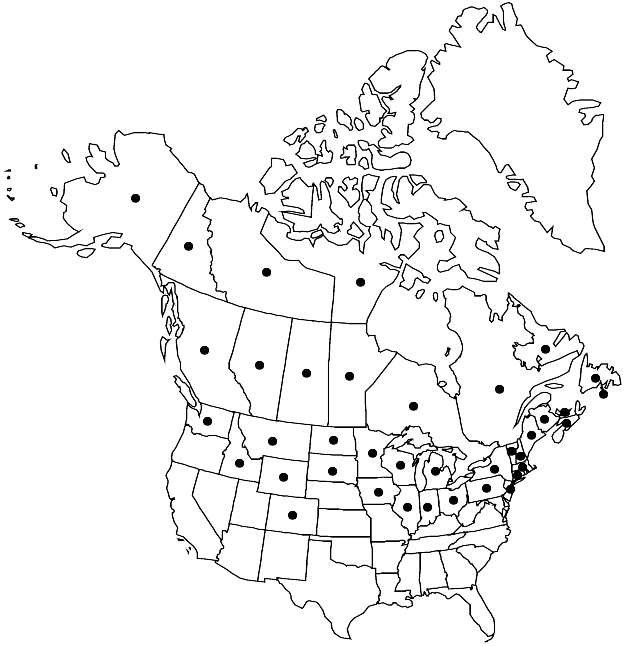Salix candida
Sp. Pl. 4: 708. 1806.
Plants often forming clones by layering. Stems: branches dark gray-brown to yellowbrown, not glaucous, woolly in patches or floccose to glabrescent; branchlets yellowbrown to redbrown or gray-brown, densely (white) woolly or tomentose, sometimes floccose. Leaves: stipules rudimentary or foliaceous on early ones, late ones 2–3.6 mm, apex acute; petiole shallowly to deeply grooved adaxially, 3–10 mm, tomentose or densely (white) woolly adaxially (obscured by hairs); largest medial blade lorate, narrowly elliptic or oblanceolate, 47–103 × 5–20 mm, base convex or cuneate, margins strongly to slightly revolute, entire, or sinuate, apex acute or convex, abaxial surface glaucous (generally obscured by hairs), very densely to sparsely tomentose-woolly (cobwebby in age), hairs dull white, crinkled, adaxial dull or slightly glossy, moderately densely to sparsely tomentose, floccose, hairs dull white; proximal blade margins entire; juvenile blade yellowish green, very densely tomentose abaxially, hairs white. Catkins flowering as leaves emerge; staminate stout or subglobose, 17–39 × 8–16 mm, flowering branchlet 0.5–7 mm; pistillate densely to moderately densely flowered, stout or slender, 20–66 × 9–18 mm, flowering branchlet 1–24 mm; floral bract tawny or brown, 1.2–1.8 mm, apex rounded or acute, abaxially hairy, hairs straight to wavy. Staminate flowers: adaxial nectary narrowly oblong to oblong, 0.6–1 mm; filaments distinct or connate less than 1/2 their lengths; anthers purple turning yellow, ellipsoid, long-cylindrical, or globose, 0.4–0.6 mm. Pistillate flowers: adaxial nectary oblong, 0.4–1 mm; ovary pyriform, beak sometimes slightly bulged below styles; ovules 12–18 per ovary; styles 0.3–1.9 mm. Capsules 4–6 mm. 2n = 38.
Phenology: Flowering mid Apr-early Jul.
Habitat: Floodplains, marl bogs, fens, and meadows, calcareous substrates
Elevation: 10-2800 m
Distribution

St. Pierre and Miquelon, Alta., B.C., Man., N.B., Nfld. and Labr., N.W.T., N.S., Nunavut, Ont., P.E.I., Que., Sask., Yukon, Alaska, Colo., Conn., Idaho, Ill., Ind., Iowa, Maine, Mass., Mich., Minn., Mont., N.H., N.J., N.Y., N.Dak., Ohio, Pa., S.Dak., Vt., Wash., Wis., Wyo.
Discussion
Occurrence of Salix candida in Nunavut is on Akimiski Island in James Bay.
Salix candida is geographically wide-ranging but limited to calcareous habitats and, for that reason, it is quite local or even rare in some parts of its range.
Hybrids:
Salix candida forms natural hybrids with S. bebbiana, S. brachycarpa var. brachycarpa, S. calcicola, S. eriocephala, S. famelica, S. myrtillifolia, S. petiolaris, and S. planifolia. Hybrids with S. discolor, S. petiolaris, and S. sericea have been reported (the latter also by C. K. Schneider 1921; M. L. Fernald 1950) but no convincing specimens have been seen. Salix candida hybrids are recognized from their woolly indumentum that often is conspicuous on leaves, stems, and ovaries. In hybrids, these characters, especially woolly patches on ovaries, stand out as discordant variation.
Salix candida × S. eriocephala (S. ×rubella Bebb ex C. K. Schneider) was described by W. W. Rowlee and K. M. Wiegand (1896) as S. candida × S. cordata. In addition to woolly patches on the ovaries, they noted that buds of the hybrids usually are shorter, more divergent, and blunter than those in S. eriocephala, and are glabrous or hairy. Known from New York and Newfoundland; it should be expected throughout the sympatric range of the parental species.
Salix candida × S. famelica: The Saskatchewan specimen resembles S. famelica but has the leaf indumentum of S. candida.
Salix candida × S. myrtillifolia: Saskatchewan specimens combine characters of the two parents.
Salix candida × S. petiolaris: Intermediates between these species are known from Michigan and New York (W. W. Rowlee and K. M. Wiegand 1896) as well as Ontario and Saskatchewan, but can be expected wherever the two grow together. The invalid name “S. ×clarkei” is sometimes used for this hybrid.
The glabrescent form of Salix candida, forma denudata (Andersson) Rouleau, may be of hybrid origin.
Selected References
None.
Lower Taxa
"-0.52mm" is not declared as a valid unit of measurement for this property.
